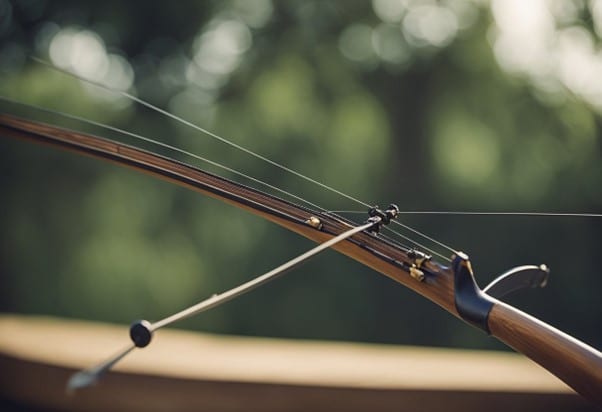The longbow, a formidable weapon of medieval battle, held significant advantages over its enemies. With its tall frame, often equal to the height of the archer, and its powerful draw, the longbow could launch arrows over considerable distances. This reach gave a strategic upper hand in battles, allowing to engage the enemy from afar and disrupt their formations before they could close the distance.

Our mastery of the longbow also translated into a higher rate of fire compared to crossbows. While the crossbow was known for its piercing power and ease of use for untrained soldiers, its reload time was cumbersome. The longbow, in skilled hands, could unleash a hail of arrows in the time it took a archer to load and fire a single bolt, providing the longbow with a critical advantage during the heat of battle.
Moreover, the versatility of the longbow was unmatched. Archers with longbows could adapt their tactics swiftly, employing a variety of arrowheads to suit the situation at hand. Whether piercing armor, causing disarray among cavalry, or targeting equipment, we made full use of the longbow's adaptability. This flexibility was not only tactical but also strategic, as it allowed to engage effectively in different types of terrain and against various forms of enemy defenses.
Historical Evolution of the Longbow
In this article, we focus on the longbow's progression from its origins to a formidable weapon of war.
Development of the Longbow
The longbow's design is a triumph of medieval engineering, reflecting centuries of refinement. By the 13th century, the English were crafting longbows from yew, ash, or elm. Measuring up to six feet in length, these longbows could harness incredible power.
We recognize the longbow as a product of skilled craftsmanship. Archers selected wood with a natural curve, shaping the longbow to achieve the optimal balance of strength, flexibility, and range.
Use in Battle
Longbows saw extensive use in battle, with a notable impact in the Hundred Years' War. The Battle of Agincourt in 1415 typifies the longbow’s devastating efficiency.
Archers organized in formations could unleash volleys that decimated opposing forces. Longbows, capable of piercing armor at a range of 200 yards, proved essential in numerous conflicts.
Material and Construction
Longbows are traditionally handcrafted from a single piece of wood, primarily yew, due to its optimal pairing of compressive and tensile strength. The back of the bow, which faces the target, is made from the yew's sapwood, which can handle tension well. The belly of the bow, facing the archer, is made of heartwood, better suited for compression. Sometimes, other woods like elm, ash, or hickory are used, and reinforcing materials such as horn or sinew can be laminated onto the wood for additional strength.
Bow Dimensions
Our typical longbow dimensions range in length from 1.8 to 2.0 meters (6 to 6.6 feet). The bow’s thickness and width may vary, but it is crucial that these dimensions are proportionate to maintain the bow's integrity and performance. The set of the bow, meaning its curvature when unstrung, usually adheres to the shape of a "D" in profile. The cross-sectional shape of the limb is often circular or a flattened oval. These precise measurements influence the draw weight, which for a traditional English longbow can be anywhere from 45 to 75 pounds, depending on its use.
Arrow Types
Arrows used with longbows are equally diverse and meticulously made. Arrow shafts are typically constructed from woods like ash or birch. They are fletched with feathers, commonly from geese or swans, which stabilize the arrow in flight. The heads of the arrows vary depending on the intended use:
- Bodkin points: Used for piercing armor and are characterized by their narrow, sharp, and pointed tips.
- Broadheads: Feature wide, flat blades for hunting, delivering greater damage to the target.
- Blunt heads: Often used for small game or practice, designed to stun rather than penetrate.
Tactical Superiority

Range and Power
The longbow was a formidable weapon in medieval warfare due to its significant range and penetrating power. Archers could hit targets up to 300 yards away, far surpassing the reach of other contemporary ranged weapons. This power came from the longbow's tall stature, often equal to the height of the archer, and its construction from yew, which provided a perfect blend of flexibility and strength.
Longbow Characteristics | Details |
Material Used | Yew, ash, or elm |
Typical Length | 6 feet (1.8 meters) |
Draw Weight | Between 80–120 pounds (36–54 kg) |
Effective Range | Up to 300 yards (274 meters) |
Rate of Fire
We are able to identify a distinct advantage in the longbow's rate of fire when compared with crossbows. An experienced archer could release between 10 to 12 arrows per minute. In contrast, crossbows might manage only 2 to 3 bolts in the same timeframe. This rapid rate of fire ensured a high volume of arrows which overwhelmed opponents and disrupted their formations.
- Longbow Rate: 10-12 arrows/minute
- Crossbow Rate: 2-3 bolts/minute
Mobility on the Battlefield
The mobility with the longbow was a crucial tactical element, particularly in the open field. The ease with which archers could carry and deploy the longbow allowed to maneuver quickly across the battlefield and fire from a variety of positions. This mobility also enabled archers to readily adapt to shifting battle conditions, exploiting the terrain and repelling cavalry charges effectively.
Advantages of Longbow Mobility:
- Quick Maneuvering: Swift repositioning to capitalize on tactical advantages.
- Versatile Firing Positions: Ability to shoot from standing, kneeling, or on the move.
- Adaptability: Effective against both infantry and cavalry units.
Impact and Legacy
The longbows legacy is exemplified by its significant influence on battle tactics and the role it played in pivotal conflicts such as the Hundred Years' War.
Role in the Hundred Years' War
During the Hundred Years' War (1337-1453), the longbow proved to be one of our most effective weapons against French forces. Its rapid rate of fire and long range dealt devastating blows that shaped the dynamics of many confrontations.
Hundred Years' War Key Facts:
Battle | Date | Significance |
1340 | England's naval dominance established by longbowmen | |
1346 | Longbow volleys decimated French cavalry | |
1356 | Helped capture French King John II | |
1415 | Outnumbered English forces triumphed |
Archers were integral to English victories throughout the Hundred Years' War, often providing a tactical advantage over heavily armored knights and archers. Their contributions significantly influenced the war's outcome and demonstrated the longbow's enduring legacy in medieval warfare history.

